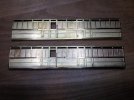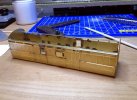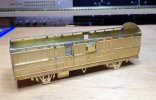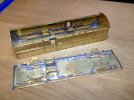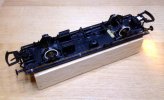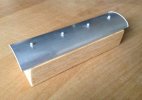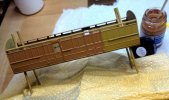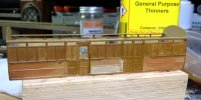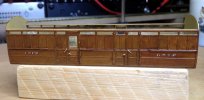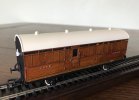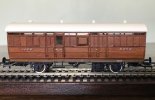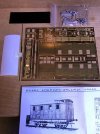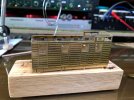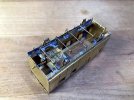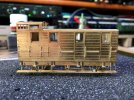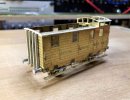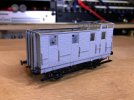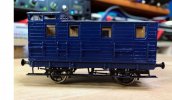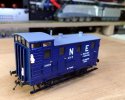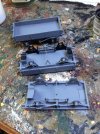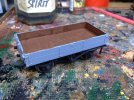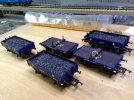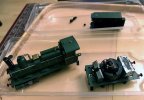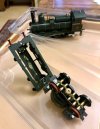A quick update on the LRM GNR C2: I've finally done the dark green infill areas and, as recommended by Ian Rathbone, I did them with the bow pen. I used the mix of paint with 5% linseed oil added, to retard the drying sufficiently to allow the different areas of the bunker and the side tanks to settle into one film before drying.
I've found doing this part by far the most difficult - there's a lot to take care of all at the same time!
As well as making sure the paint only goes where it's supposed to (no small thing!) you also have to keep the wet edge going, make sure the oil-thinned paint isn't leaking out of the side of the bow pen, keep the pen moving sufficiently fast that the paint film is thin and even, join intersecting parts only enough to let them flow together but not overlap so that a raised area forms where the coat is double thickness, plus the model has to be re-positioned halfway through (flat for the side, on edge in the vice for the rear) and everything has to be done as quickly as possible, because even with the 5% linseed oil added, it all needs to be on within a few minutes so that it settles together.
I considered several different orders for doing the various areas and had decided to do the horizonals first and then fill in between them, but keeping that wet edge is so crucial that in the end I went round each section's consecutive sides in order, so that there was only one wet edge at a time; I left the areas around the handrails until last though, because you can't do
everything at once and I reasoned that the handrails would hide any poorer joins. I did the corners on the second side by running the pen along the ruler too where possible, even though they're such small areas, because it's easier that way to keep the pen moving at the same speed as for the longer stretches and keep the paint film uniform: I'd tried doing the corners freehand the first time and it left slightly thicker paint in one or two small areas, though it's pretty unobtrusive.
I also found that because the paint is less viscous through adding the oil and flows very easily, you can hold the pen at a much wider range of angles. As you're laying each line against the last one, capillary action also helps draw out the paint, so I was able to get the pen right under the handrails - while still using them as a straight edge - where I'd anticipated having to fill in with a brush. I also realised - just as I was about to do the first line up against the side beading - that the beading and the footplate are there as ready-made straight edges! I'd got so used to use the ruler, I almost missed that!

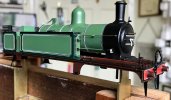
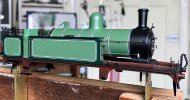
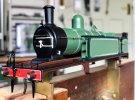


I kept the wet edge along the corner - and just over it - wet by drawing another line against it in between doing other parts, so that when I went back to fill in the final vertical, it was still wet:
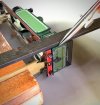
Doing the fronts of the side tanks called for some care: with the loco mounted on the stand and in the vise facing upwards, there's no way to position a ruler to do the few lines needed for the tanks' front faces, so I had to wing it, holding a square section piece of wood as a floating guide - actually a large firelighter matchstick I had in the house:
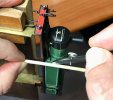
I'm holding the left-hand end of the wood with my left hand, but the right-hand end is free, resting upwards against the underside of my thumb. I got away with it because the parallel touching lines you do for infills like this don't have to be terrifically accurate, providing they flow well and settle together into one coat. Next time I do something like this though, I'll work out a better way to do it!

